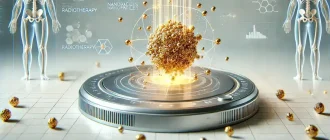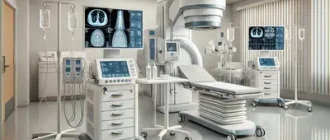Kidney cancer is a serious health concern, with renal cell carcinoma (RCC) being the most common type. Traditional treatment options include surgery (partial or radical nephrectomy), targeted therapies, and conventional radiation therapy. However, for patients who are not ideal candidates for surgery due to age or comorbidities, alternative treatment modalities are essential.
Patient Satisfaction with SBRT
| Satisfaction Level | Percentage (%) |
|---|---|
| Very Satisfied | 55% |
| Satisfied | 30% |
| Neutral | 10% |
| Dissatisfied | 5% |
This chart represents patient satisfaction with SBRT treatment. The majority of patients reported being very satisfied or satisfied, with a small percentage expressing neutral or dissatisfied opinions.
Stereotactic Body Radiation Therapy (SBRT) is emerging as an effective, non-invasive treatment for kidney cancer, offering high precision in targeting tumors while minimizing damage to surrounding healthy tissues. This article explores SBRT, its benefits, mechanisms, and how it compares to other treatment options.
What is Stereotactic Body Radiation Therapy (SBRT)?
SBRT is an advanced form of radiation therapy that delivers highly focused, high-dose radiation to tumors with extreme precision. Unlike conventional radiation therapy, which is administered over several weeks with lower daily doses, SBRT is typically completed in 3-5 sessions over one to two weeks. This technique is particularly beneficial for treating tumors in areas where preserving surrounding healthy tissue is critical.
How Does SBRT Work for Kidney Cancer?
SBRT utilizes advanced imaging techniques and computer-guided technology to deliver targeted radiation beams precisely to the tumor. This results in:
- High-dose radiation concentrated on the tumor while sparing nearby organs, such as the remaining kidney and intestines. This is achieved through real-time imaging and motion tracking, ensuring that radiation is delivered only when the tumor is within the planned target zone, much like a GPS system guiding a vehicle with pinpoint accuracy.
- Minimized damage to surrounding healthy tissue, reducing the risk of complications. Unlike conventional radiation therapy, where surrounding tissues may receive unintended exposure, SBRT sharply confines the radiation beam, similar to using a high-powered laser to etch a fine design without affecting surrounding material.
- Effective tumor control, with studies showing local control rates of approximately 97% within a year post-treatment. This success rate is comparable to surgical outcomes but without the risks associated with anesthesia and post-surgical recovery, making it a valuable option for patients who cannot undergo surgery.
Benefits of SBRT for Kidney Cancer Patients
- Non-invasive alternative to surgery: Ideal for patients who cannot undergo surgery due to health conditions.
- Shorter treatment duration: Compared to conventional radiation therapy, which may take several weeks.
- High success rates: Clinical studies indicate that SBRT offers excellent local tumor control, reducing tumor size in approximately 34.5% of cases, while stabilizing tumor growth in 65.5% of patients over a median follow-up period of 25 months.
- Minimal impact on kidney function: Research suggests that significant kidney damage is rare, and none of the patients in certain studies required dialysis post-treatment.
Comparison of SBRT vs. Conventional Radiation Therapy
| Aspect | SBRT | Conventional |
|---|---|---|
| Duration (Weeks) | 1-2 Weeks | 5-7 Weeks |
| Precision | High | Moderate |
| Side Effects | Lower | Higher |
This chart compares SBRT (Stereotactic Body Radiation Therapy) with Conventional Radiation Therapy based on duration, precision, and side effects. SBRT offers a shorter treatment time, higher precision, and reduced side effects, making it a preferable option for certain cases.
What to Expect During SBRT Treatment
- Pre-treatment planning:
- Imaging scans (CT, MRI, or PET) to map tumor location, ensuring precise radiation delivery.
- A simulation session where patients are positioned, and immobilization devices may be used to minimize movement. This ensures accuracy during radiation delivery, akin to how a sculptor carefully aligns their chisel before carving.
- Treatment process:
- Typically delivered in 3-5 sessions over 1-2 weeks, significantly shorter than traditional radiation therapy, which can last for several weeks.
- Each session lasts about 30-60 minutes, comparable to a standard outpatient visit.
- The procedure is painless, requiring no hospitalization, much like undergoing an advanced imaging scan where the patient remains still while the machine operates.
- Post-treatment monitoring:
- Follow-up scans (such as MRI or CT) to assess tumor response, similar to routine imaging scans for cancer follow-up.
- Regular check-ups to monitor kidney function and side effects, ensuring that any minor complications are managed early. This is much like periodic maintenance checks on a car to ensure everything is running smoothly and prevent major issues.
Potential Side Effects and Management
While SBRT is generally well tolerated, some patients may experience:
- Mild fatigue: Usually temporary and manageable with rest. Patients are encouraged to maintain hydration and a balanced diet to combat fatigue. Light exercise, such as walking, can also aid in improving energy levels post-treatment.
- Nausea or skin irritation: Can be controlled with medications and topical treatments. Physicians may recommend anti-nausea medications or dietary adjustments to minimize discomfort. Skin irritation, though rare, can be alleviated with gentle skincare routines and avoiding direct sun exposure on treated areas.
- Rare kidney function changes: Studies show that severe kidney damage is uncommon, and most patients retain normal renal function post-treatment. Regular kidney function tests will be conducted post-SBRT to monitor any subtle changes, states iythealth.com. Patients should stay well-hydrated and consult their physician if they notice unusual symptoms such as swelling or changes in urination patterns.
Who is a Candidate for SBRT?
SBRT is typically recommended for:
- Patients with early-stage localized kidney cancer.
- Individuals unfit for surgery due to age, heart disease, or other comorbidities.
- Patients seeking a non-invasive treatment option with high efficacy.
Comparing SBRT to Other Treatment Options
| Treatment Option | Pros | Cons |
|---|---|---|
| Surgery | Gold standard; complete tumor removal | Invasive, requires recovery time |
| Radiofrequency/Cryoablation | Minimally invasive, effective for small tumors | Requires needle insertion, potential for recurrence |
| Active Surveillance | No immediate treatment required | Risk of tumor progression |
| SBRT | Non-invasive, high tumor control rates | Potential mild side effects |
Recent Research and Outcomes
A 2024 study found that after a median follow-up of 25 months, 34.5% of patients experienced tumor size reduction, while 65.5% had tumor stabilization. Additionally, overall survival rates at one and two years were 100%, making SBRT a highly promising treatment for localized kidney cancer.
Editorial Advice
SBRT is revolutionizing the treatment landscape for kidney cancer, especially for those unable to undergo surgery. If you or a loved one are exploring treatment options, discussing SBRT with your healthcare provider could be a game-changer. Its precision, minimal invasiveness, and impressive success rates make it a strong alternative to traditional therapies.
For the best outcomes, consult with a specialized oncologist experienced in SBRT. Your health journey is unique—choosing the right treatment is crucial for long-term success.
Comparison of SBRT Costs vs. Other Kidney Cancer Treatments
| Treatment Type | Cost (USD) |
|---|---|
| SBRT | $20,000 |
| Surgery | $50,000 |
| Immunotherapy | $35,000 |
| Targeted Therapy | $40,000 |
This chart compares the cost of SBRT with other kidney cancer treatments. While SBRT is generally more cost-effective than surgery, other treatments such as immunotherapy and targeted therapy fall in between in terms of expense.
About the Author
Reyus Mammadli is the author of this health blog since 2008. With a background in medical and biotechnical devices, he has over 15 years of experience working with medical literature and expert guidelines from WHO, CDC, Mayo Clinic, and others. His goal is to present clear, accurate health information for everyday readers — not as a substitute for medical advice.







